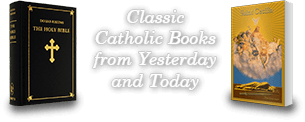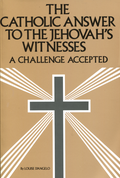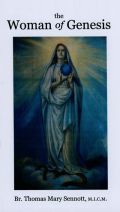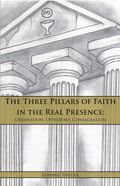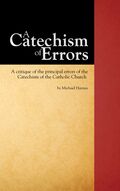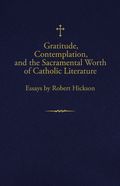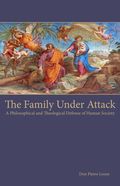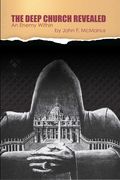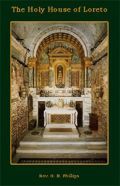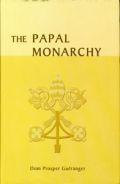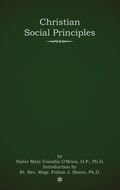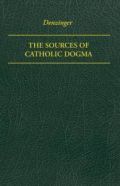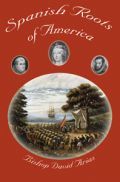Categories
Information
Apologetics
192 pages, softcover
By Louise D'Angelo
This book presents to the reader the information which they need to protect their own faith or the faith of someone they love from the attacks of the Witnesses. This book was written after 16 years of toil and research by the author. There is nothing like it in print today. It contains full explanations of what the Witnesses believe and how they use the Bible to try to trap unsuspecting Catholics.
Sr. Mary Concilia O'Brien - Hardcover - 478 pages
This brilliantly concieved and executed textbook was published for Catholic High School & College students. It was published in 1941 and it is still one of the clearest and succinct summaries of Catholic Social teaching. It draws primarily on the teaching of St. Thomas in the Summa and the papal encyclicals of Leo III and Pius XI. There are chapter summaries, questions for further discussion, lists of primary sources quoted, an extensive index, and suggested reading for advanced students. This is an invaluable resource for neophytes in the study of the Church's social doctrines.
Originally published in 1984 This short book brilliantly exposes the "higher criticism" which purports to undermine the true Catholic reading and meaning of Genesis 3:15. See how Br. Thomas uses the fictional character Maria Stephan to 'step on' and crush the ridiculous arguments of the modern Catholic and protestant so-called biblical scholars.
The Three Pillars of Faith in the Real Presence: Ordination, Offertory, Consecration - EBOOK - PDF, Kindle, & EPUB
Edward Snyder -146 pages
Since the introduction of the Novus Ordo liturgy in the 1960s, Catholic belief in the Real Presence and the essential sacrificial nature of the Mass and of the priesthood has declined precipitously. In addition, the number of men entering the priesthood and the percentage of Catholics regularly attending Mass has also fallen off dramatically. When seeking answers to why these facts are so, the author of this treatise, Edward Snyder, has undertaken a substantive study of the words used in both the ancient and the new liturgy and arrived at some startling discoveries and conclusions.
Since belief in the Holy Sacrifice of the Mass and Christ’s true presence in the consecrated host are beliefs central and essential to the Catholic religion, it is important to understand why these beliefs are no longer held by so many. Certain core doctrines believed by the first Christians were supported by the linguistic evidence they left in the New Testament. What does this linguistic evidence consist of? Specifically, about the year 325 B.C. the Hebrew Old Testament was translated into Greek. This translation was done by seventy Hebrew scholars and it is known as the Septuagint. The Greek and Latin New Testament texts contain many semitisms—that is words that were used based on the Aramaic spoken and written by the Church when the original Christians were primarily Aramaic speaking—that can only be properly translated into English, or any other vernacular language, if the Hebrew roots are understood.
This philological study of the root of words used in the scriptures and the liturgy will be most useful as an aid to understanding why clarity of belief is disappearing so rapidly in the Church of our day.
We are indebted to Brian Kranick for this illuminating exposition of the Book of Exodus. One who reads this book will have a
much clearer understanding of the four Gospels because Exodus, along with the prophecy of Isaias, is the best and clearest revelation
in the Old Testament of the Savior to come and his mission.
The typology that the Fathers and Doctors of the Church have spoken of is here collected and examined and presented for our
edification. One glance at the table of contents will be enough to convince you that this book is crucial for understanding the
Gospels and the history of God’s people both in the Old and New Testaments.
He specifically reminds us of the fact that God himself designed all of the liturgical seasons and feasts and that he also
gave explicit directions for every minute rubric and prayer of all of the liturgical rites, sacrifices, and architecture. Our Lord and his
apostles carried on these rituals in the new and eternal sacrifice, not only the one on Calvary, but also in the continuing sacrifice
of the Mass as given to us by Our Lord himself. That ritual had for almost 2000 years been called the Roman Rite.
After reading this book you will re-read the Gospels, especially the descriptions of the Passion, with new “eyes to see.” But if
the Gospels are newly enlivened for you, just wait until you assist at the Holy Sacrifice of the Mass in the Roman Rite once again.
It becomes a deeper and more contemplative experience because now, the Book of Exodus, through this work will have been
opened to you, and the phrase from Luke 24:32; “Were not our hearts burning [within us] while he spoke to us on the way and
opened the scriptures to us?” shall amaze you with its immanent relevance to each of us in today’s increasingly perfidious, and
therefore confusing, world.
By M. L. Cozens - 118 pages - Paperback
This most concise and helpful reference work was first published in 1928. It was reissued in 1945 by Sheed & Ward publishers and is presented by Loreto again in 2016 because we feel it will be very useful for students, seminarians, priests, and Catholic laity of all walks of life, since so many of these heresies are once again rearing their ugly heads in these most troubling times. Therefore, we must be not only quick to recognize their manifestation in the era in which we live, but we should also be capable of the refutation of these death-dealing errors for those who would look to faithful Catholics for guidance.
Saint Paul in 1Cor. 11:19 says “For there must be also heresies: that they also, who are approved, may be made manifest among you.” Now at first impression that might seem an odd thing for Saint Paul to say— that there must be heresies? Yet the verse gives its own explanation. It is so that truth (those approved teachers and believers) may be made clear among you. It is often the case that truth or light stands out more clearly when contrasted against untruth or darkness and that is one very fine reason why those seeking the truth in more depth of understanding may wish to study heresies. It is so that truth may be made more manifest!
That is exactly what the author does in this book. Not only does he
explain and state clearly the errors but he does three other things that are most helpful to the reader: 1) he describes how and why the heresy arose, and 2) he shows the true teachings in opposition, and 3) he draws out the logical conclusions and implications for thought and behavior that flow from the acceptance of the error. This is a great teaching tool for high schools, colleges and seminaries, or adult study groups.
Saint Anthony - Hammer of Heretics - Pray for us!
Ebook: epub, mobi, and pdf.
By Michael Haynes with an Introduction by Archbishop Viganò - PB 164 pages
Sixty years after the Pastoral Council, that the promotional advertising told us was to usher in a new springtime for the Church, is sufficient time for the faithful to stand back and calmly observe the glorious fruits of the work of that Council. We at Loreto have done so, and many Catholics (even some who have spent years committed to implementing the principles of Vatican II) have done so as well. The historical facts appear to us to belie the promises made by Pope John XXIII and others.
As Pope John Paul II said, three of the most important fruits of the Council are: the New Liturgy and sacramental rites, the New Code of Canon Law and the New Catechism. With all of these brand new and very modern(ist?) post-Conciliar alterations in the laws and teachings of the hierarchy forced upon the faithful having had its trial of sixty years, it is now time to judge these fruits objectively. Surely, even those who have collaborated, either wholeheartedly or with reservations, in the advancement of these changes must agree that a just and prudent accounting should now be made of the blessings or curses upon the Church and the world resulting from the work of the Council.
This penetrating analysis produced by Michael Haynes under the direction of a faithful Priest, and prefaced by a faithful Shepherd, Archbishop Carlo Maria Viganó is what we hope will be a first of many groundbreaking studies of the new Catechism.
25 Essays by Robert D. Hickson - 640 pages - EBOOK - PDF, Kindle, & EPUB
Archbishop Vigano's Preface
Memory is a fundamental element of a people’s identity, civilization and
culture: a society without memory, whose patrimony consists solely of a
present without a past, is condemned to have no future. It is alarming that
this loss of collective memory affects not only Christian nations, but also
seriously afflicts the Catholic Church herself and, consequently, Catholics.
This amnesia affects all social classes and is not the result of chance, but of
systematic work on the part of those who, as enemies of the True, Good
and Beautiful, must erase any ray of these divine attributes from even the
most marginal aspects of social life, from our idioms, from memories of
our childhood and from the stories of our grandparents. The Orwellian
action of artificially remodeling the past has become commonplace in the
contemporary world, to the point that a class of high school students
are unable to recognize an altarpiece depicting a scene from the life of
Christ or a bas-relief with one of the most revered saints of the past. Dr.
Robert Hickson calls this inability “deficiency of dogmatic understanding”,
“Catholic illiteracy of pestilential proportions”.
Tabula rasa: millions of souls who only twenty or thirty years ago would
have immediately identified the Baptism of the Lord in the Jordan or
Saint Jerome or Saint Mary Magdalene are capable of seeing only two men
along a river, an old man with a lion and a woman with a vase. Reading
the pages of Dante, Manzoni or one of the great Christian writers of the
past, many Catholics can no longer grasp the moral and transcendent
sense of a culture that is no longer their common heritage, a jealously
guarded legacy, the deep root of a robust plant full of fruit.
In its place we have a bundle of the confused rubbish of the myths of the
Revolution, the dusty Masonic ideological repertoire, and the iconography
of a supposed freedom won by the guillotine, along with the persecution
of the Church, the martyrdom of Catholics in Mexico and Spain, the
end of the tyranny of Kings and Popes and the triumph of bankers and
viii Gratitude, Contemplation, and the Worth of Catholic Literature
usurers. A lineage of kings, saints, and heroes is ignored by its heirs, who
stoop to boasting about their ancestors who were criminals, usurpers,
and seditious traitors: never has falsification reached the point of such
incomprehensible perversion, and it is evident that the desire to artificially
create such ancestry is the necessary premise for the barbarization of the
offspring, which is now practically accomplished.
We must also recognize that this removal has found significant
encouragement also among those who, within the Catholic Church,
have erased two thousand years of the inestimable patrimony of faith,
spirituality and art, beginning with a wretched sense of inferiority instilled
in the faithful even by the Hierarchy since Vatican II. The ancient apostolic
liturgy, on which centuries of poetic compositions, mosaics, frescoes,
paintings, sculptures, chiseled vases, illuminated chorales, embroidered
vestments, plainchants and polyphony have been shaped, has been
proscribed. In its place we now have a squalid rite without roots, born
from the pen of conspirators dipped in the inkwell of Protestantism; music
that is no longer sacred but profane; tasteless liturgical vestments and
sacred vessels made of common material. And as a grey counterpoint to
the hymns of St. Ambrose and St. Thomas, we now have poor paraphrases
without metrics and without soul, grotesque paintings and disturbing
sculptures. The removal of the admirable writings of the Fathers of the
Church, the works of the mystics, the erudite dissertations of theologians
and philosophers and, in the final analysis, of Sacred Scripture itself –
whose divine inspiration is sometimes denied, sacrilegiously affirming
that it is merely of human origin – have all constituted necessary steps
of being able to boast of the credit of worldly novelties, which before
those monuments of human ingenuity enlightened by Grace appear as
miserable forgeries.
This absence of beauty is the necessary counterpart to an absence of
holiness, for where the Lord of all things is forgotten and banished, not
even the appearance of Beauty survives. It is not only Beauty that has
been banished: Catholic Truth has been banished along with it, in all its
crystalline splendor, in all its dazzling consistency, in all its irrepressible
capacity to permeate every sphere of civilized living. Because the Truth
is eternal, immutable and divisive: it existed yesterday, it exists today
and it will exist tomorrow, as eternal and immutable and divisive as the
Word of God.
Certainly, behind this induced amnesia, there is a Trinitarian heresy. And
where the Deceiver lurks, the eternal Truth of God must be obscured in
order to make room for the lie, the betrayal of reality, the denial of the past.
In a forgery that is truly criminal forgery, even the very custodians of the
depositum fidei ask forgiveness from the world for sins never committed by
our fathers – in the name of God, Religion or the Fatherland – supporting
the widest and most articulated historical forgery carried out by the
enemies of God. And this betrays not only the ignorance of History which
is already culpable, but also culpable bad faith and the malicious will to
deceive the simple ones.
Rediscovering memory, even in literature, is a meritorious and necessary
work for the restoration of Christianity, a restoration that is needed
today more than ever if we want to entrust to our children a legacy to be
preserved and handed down as a tangible sign of God’s intervention in
the history of the human race: how much Providence has accomplished
over the centuries – and that art has immortalized by depicting miracles,
the victories of the Christians over the Turk, sovereigns kneeling at the
feet of the Virgin, patron saints of famous universities and prosperous
corporations – can be renewed today and especially tomorrow, only if we
can rediscover our past and understand it in the light of the mystery of
the Redemption.
This book proposes the noble purpose of restoring Catholic memory,
bringing it back to its ancient splendor, that is, the substance of a
harmonious and organic past that has grown and still lives today, just as
the hereditary traits of a child are found developed in the adult man, or
as the vital principle of the seed is found in the sap of the tree and in the
pulp of the fruit. Robert Hickson rightly shows us, in the restoration of
memory, the way to rediscover the shared faith that shapes the traits of a
shared Catholic culture.
In this sense it is significant – I would say extremely appropriate, even if
only by analogy – to have also included Christian literature among the
Sacramentals, applying to it the same action as that of blessed water, the
glow of the candles, the ringing of bells, the liturgical chant: the invocation
of the Virgin in the thirty-third canto of Dante’s Paradiso, the dialogue
of Cardinal Borromeo with the Innominato, and a passage by Chesterton
all make Catholic truths present in our minds and, in some way, they
realize what they mean and can influence the spiritual life, expanding
and completing it. Because of this mystery of God’s unfathomable mercy
we are touched in our souls, moved to tears, inspired by Good, spurred
to conversion. But this is also what happens when we contemplate an
altarpiece or listen to a composition of sacred music, in which a ray of
divine perfection bursts into the greyness of everyday life and shows us the
splendor of the Kingdom that awaits us.
The author writes: “We are called to the commitment to recover the life and
full memory of the Body of Christ, even if in our eyes we cannot do much to
rebuild that Body”. But the Lord does not ask us to perform miracles: He
invites us to make them possible, to create the conditions in our souls and
in our social bodies so that the wonders of divine omnipotence may be
manifested. To open ourselves to the past, to the memory of God’s great
actions in history, is an essential condition for making it possible for us to
become aware of our identity and our destiny today so that we may restore
the Kingdom of Christ tomorrow.
+ Carlo Maria Viganò
Titular Archbishop of Ulpiana
Apostolic Nuncio
28 August 2020
Saint Augustine
Bishop, Confessor, and Doctor of the Church
Don Pietro Leome - PB 246 pages - EBOOK - PDF, Kindle, & EPUB
In our days the war against God and His Church has become deeper and broader than at any time in history. No longer are the powers of darkness content to attack only the institutional Church that God founded. The truth is that the human nature that God the Father created is now the subject of the adversary’s most violent persecution, and through the undermining of the very concept of human nature and the natural law enshrined in it the enemies of God hope to make any consideration of the concept of ‘super-nature’ and super-natural life disappear from the minds of men.
The Church has always been the true guardian of not only supernatural life, but of the natural law as well. Since the natural law is the law that God put into our nature and it is discernible in the light of reason, the Church, speaking for God, is the champion of sound reasoning. With the natural law as well as supernatural law governing human sexuality and family life under attack, Don Pietro Leone has risen to defend (and to properly distinguish) those areas, so that those who wish to defend the Church and human society in our age may have sound teaching upon which to base their actions.
In the course of this treatment of these topics he makes a detailed critique of certain novel presentations of themes found in the Magisterium from the time of the Second Vatican Council onwards. Amongst these doctrines is one he terms ‘Magisterial Personalism’ and another called the ‘Theology of the Body.’ Drawing upon scholastic philosophy and the perennial teaching of the Church, Don Pietro brings light to a subject recently plunged into obscurity and darkness that is not currently being dispelled sucessfully, even by the guardians of Truth themselves.
By John F. McManus - 244 pages PB - EBOOK - PDF, Kindle, & EPUB
This book, written by a prominent and well known Catholic American, is
the product of almost seventy years of close observation and deep study in a
turbulent world of rapid change and degradation of church and society.
Recently, the courageous Archbishop Carlo Maria Viganò published an acknowledgment
of the problems discussed in this book in his now world famous Open Letter to
President Trump where he spoke of Freemasonry and the ‘deep church’. Because
that letter appeared as this book was going to press, The Deep Church Revealed
was added to the original title as a fitting description of its content.
The revealing begins with a description of the Enlightenment philosophers
and their anti-Catholic hatred, and the author proceeds from there to detail in
forty-one astonishing chapters the story of how those men and the organizations
they inspired grew and and spread their pernicious doctrines throughout the
world and the Church.
The plans that these Freemasonic organizations laid were remarkably successful,
even though vigorously opposed by every Pope for over 200 years. “An
enemy hath done this” Our Lord said in the parable of the wheat and the cockles.
Truly, this can be said today of the situation in His Church. The holy and
vigilant Padre Pio told Fr. Luigi Villa in 1963 when he assigned Fr. Villa the task
of exposing these enemies “Courage, courage, courage! For the Church is already
invaded by Freemasonry that has already reached the Pope’s slippers.”
We are thankful to Mr. McManus for telling this story briefly, succinctly,
and with unbounded love for our Holy Mother the Church. He advises us,
like Saint Peter, “Be sober and watchful, for your adversary the devil goeth
about like a roaring lion, seeking whom he may devour. Whom ye should
resist, fortes in fide.”
Rev. G. E. Phillips - EBOOK - PDF
This history of the Holy House of Loreto is the most decisive work in English defending the authenticity of this most hallowed shrine in all Christendom. Our Lady’s Holy House at Nazareth was taken by angels to Dalmatia (Croatia) in 1291 to prevent its desecration by the infidels. Three years later it took flight again to rest in Loreto, Italy, where it remains. Rev. Phillips provides the facts, and excitement behind the story. Many cures, apparitions, and miraculous conversions, have happened within the limestone walls of the Santa Casa.
Ebook (pdf) Dom Prosper Guéranger Abbot of Solesmes
Translated from the French Third Edition by Michael J. Miller
When nineteenth century Christendom shifted its allegiance from a divine vertical authority to the horizontal revolutionary ideals of egalitarian democracy and false liberty, Dom Guéranger’s erudite polemical masterpiece contributed more than any other contemporary work to uphold the papal monarchy in all of its divinely ordained prerogatives. This labor of the holy abbot helped to restore in Catholic Europe the spiritual sword, as well as the magisterial cathedra, to the Vicar of Christ the King. And he did so, not by any clever manipulative abuse of language, but simply by appealing to the simplicity and clarity of the gospels, universal Christian tradition, and the common consensus fidelis. The brilliant hypothetical scenario, drawn by the author, of a college of a dozen apostles, called by Christ, but without a “Cephas” (a Rock) in Peter and his successors, presents even the infant “collegial” church in such an unenviable plight that one might pity them even more than one might pity the Methodists or Seventh Day Adventists, had any of them been at the marriage feast of Cana.
Ebook files: mobi, epub, and pdf
Sr. Mary Concilia O'Brien - Hardcover - 478 pages
This brilliantly concieved and executed textbook was published for Catholic High School & College students. It was published in 1941 and it is still one of the clearest and succinct summaries of Catholic Social teaching. It draws primarily on the teaching of St. Thomas in the Summa and the papal encyclicals of Leo III and Pius XI. There are chapter summaries, questions for further discussion, lists of primary sources quoted, an extensive index, and suggested reading for advanced students. This is an invaluable resource for neophytes in the study of the Church's social doctrines.
EBOOK - PDF
In this age of doctrinal latitude and speculative innovation there is a pressing need for a comprehensive source book on authentic Catholic dogma that is magisterially anchored while at the same time both practical and non-voluminous. You have such a book in this English translation of Father Heinrich Denzinger’s Enchiridion Symbolorum et Definitionum. Since it was first published a century and a half ago, this handbook or collection (enchiridion) of articles (symbols) of faith and morals has enjoyed universal appeal and approbation since the pontificate of Blessed Pope Pius IX. The Enchiridion has been updated periodically; the edition being offered here by Loreto is that issued in 1957. The collection includes all articles and creeds of the Catholic Faith beginning with that of the twelve apostles, all dogmatic definitions stamped with the Petrine authority of the apostolic See (ex cathedra), decrees of the solemn magisterium, papal bulls, encyclicals and letters, as well as some of the more weighty decisions of the Holy Office prior to 1957. Although not every entry in this 653 page compendium of Church teaching is definitional (i.e. ex cathedra) it still should be considered the "locutus est" for every wayfaring Catholic whose patria, this side of heaven, is Roma. In addition to a general index there is a scriptural index plus an invaluable systematic or topical index making for very easy reference. Note, too, this edition comes with a one page Corrigenda which is a list of sixteen corrections that must be applied to errors (usually omissions) that escaped the eyes of editors in previous editions.
Bishop David Arias- EBOOK - PDF
This is an American history book written from the Spanish perspective. The author, Auxiliary Bishop of the Archdiocese of Newark, NJ, David Arias, is a church historian, born and educated in Leon, Spain. This magnificent chronological itinerary through the history of the USA from 1492 to the present should be read in American history class and in every Catholic American home. Without it you are missing a very large part of the true picture of our nation's history. This is a great book for Catholic homeschoolers and highschool students.

